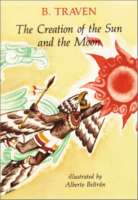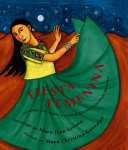
This beautiful Mexican legend tells the story of a young Indian hero who saves mankind by rekindling the Sun after it has been extinguished by the spirits of evil.
Material appropriate for intermediate age groups

This beautiful Mexican legend tells the story of a young Indian hero who saves mankind by rekindling the Sun after it has been extinguished by the spirits of evil.

Karli loses his parentes in an accident and goes to live with his grandmother. Now they both have to adjust to living together. The relationship between Karli and his grandmother blossoms into a beautiful friendship.

Based on the life of Charlotte Parkhurst, this rollicking adventure story traces the daring and unusual escapades of a real 1860’s girl who disguised herself as a man so she could live, work, and vote as she pleased.

The award-winning Talking Walls and its sequel, Talking Walls: The Stories Continue, introduce young readers to different cultures and different issues around the world by telling the stories of walls and how they can hold a community together or separate it. Featured walls include the Great Wall of China, the murals of Diego Rivera, Nelson Mandela’s prison walls, a Holocaust memorial in Poland, Ndebele wall designs in South Africa, Hadrian’s Wall in England, and the Peace Lines in Belfast, Northern Ireland. These books will spark the curiosity of young readers as they learn about their world and its amazing diversity. Teacher’s guide available.

This Spanish translation of the historical novel I, Juan De Pareja is based on the life of Juan de Pareja, the black assistant to the 17th-century Spanish painter Velazquez. Newbery Medal Book.
Mexican archeology.

“A retelling of several key Aztec myths, with background information describing the history, geography, belief systems, and customs of the Aztecs”–Provided by publisher.
 Corinna Stonewall is 15 years old and an orphan. She is also Rhysbridge Foundling Home’s Folk Keeper – a difficult and dangerous job which consists of looking after and controlling ‘the Folk’ – spiteful, maverick, savage creatures who live in the cellar and will only be prevented from spoiling the milk, terrifying the livestock and other disruptions by gifts of cream, salt pork and other luxuries. But there are many questions about Corinna. Who are her parents? Why does her hair grow two inches a night? Why does she feel drawn to the sea and long for the sweet taste of fish?
Corinna Stonewall is 15 years old and an orphan. She is also Rhysbridge Foundling Home’s Folk Keeper – a difficult and dangerous job which consists of looking after and controlling ‘the Folk’ – spiteful, maverick, savage creatures who live in the cellar and will only be prevented from spoiling the milk, terrifying the livestock and other disruptions by gifts of cream, salt pork and other luxuries. But there are many questions about Corinna. Who are her parents? Why does her hair grow two inches a night? Why does she feel drawn to the sea and long for the sweet taste of fish?

Fourteen-year-old Clara Luna spends the summer with her grandparents in the tiny, remote village of Yucuyoo, Mexico, learning about her grandmother’s life as a healer, her father’s decision to leave home for the United States, and her own place in the world.

Drawing from Mexico’s rich cultural heritage, storyteller Mary Joan Gerson celebrates the courage and resilience of the feminine spirit through the stories of seven extraordinary Mexican women. Maya Christina Gonzalez uses radiant colors in a style reminiscent of famous Mexican muralists to capture the spark behind the stories. A folktale collection that will be enjoyed time and again, this is truly a fiesta for the eyes, the spirit and the heart.